-
- How do SD-WAN appliances work?
- What are the different types of SD-WAN appliances?
- What are the different SD-WAN appliance deployment models?
- What are the benefits of SD-WAN appliances?
- What are the common features of SD-WAN appliances?
- Security considerations for SD-WAN appliances
- How to choose the right SD-WAN appliance for your needs
- SD-WAN appliance FAQs
Table of Contents
-
What Is WAN Optimization? [+ How It Works & Modern Role]
- Why does WAN optimization exist in the first place?
- How does WAN optimization actually work?
- Does WAN optimization still work on encrypted traffic?
- Where does WAN optimization live in modern architectures?
- What are the benefits of WAN optimization today?
- What are the limitations of WAN optimization?
- How does WAN optimization differ from SD-WAN and application acceleration?
- WAN optimizations FAQs
-
What Is an SD-WAN Gateway? | Definition, Explanation, Use Cases
- What are the limitations of hub-and-spoke architecture?
- What is the purpose of an SD-WAN gateway?
- What are the primary SD-WAN gateway use cases?
- What are the features of an SD-WAN gateway?
- What are the different types of SD-WAN gateway form factors?
- What are the disadvantages of an SD-WAN gateway?
- SD-WAN gateway FAQs
What Is an SD-WAN Appliance? | SD-WAN Hardware & Equipment
5 min. read
Table of Contents
An SD-WAN appliance is a hardware or virtual device that enables the deployment and management of SD-WAN networks. It continuously monitors multiple network connections to dynamically route traffic over the most efficient path.
SD-WAN appliances provide built-in security features like firewalls, encryption, and intrusion detection/prevention systems to protect network traffic and ensure data privacy.
How do SD-WAN appliances work?
SD-WAN (software-defined wide area network) appliances work by creating a virtual network overlay that abstracts the underlying transport services, like MPLS, broadband, and LTE. The abstraction allows the appliance to aggregate and manage these diverse WAN connections smoothly and efficiently.
The core functionality of an SD-WAN appliance is to continuously monitor network conditions like latency, packet loss, and jitter. By analyzing these metrics, the central management system makes real-time decisions about the most efficient path for data, which the appliance then enforces.
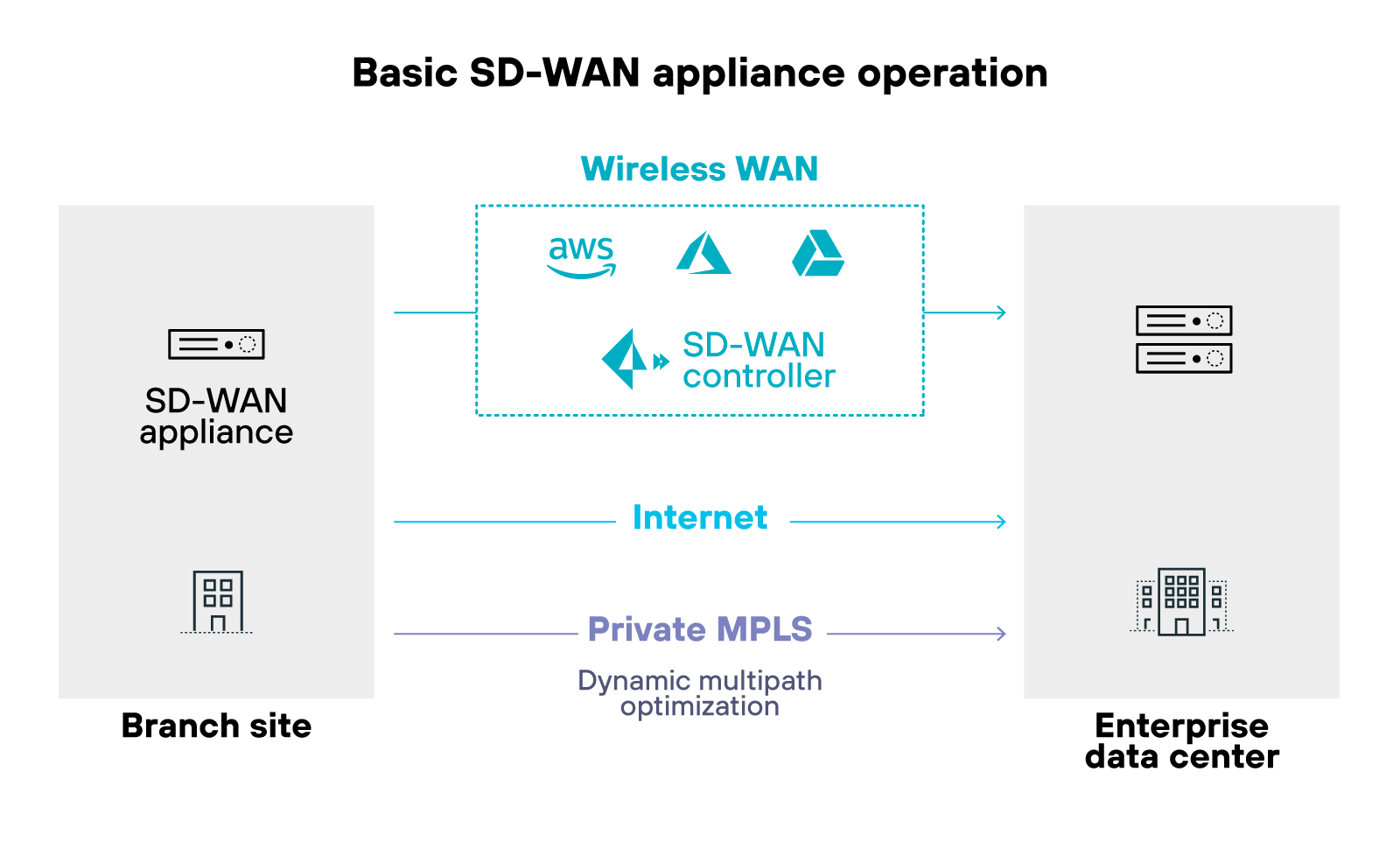
In essence:
SD-WAN appliances continuously analyze network conditions, make real-time routing decisions, and apply security measures to maintain optimal performance and security.
Here's a step-by-step breakdown of how SD-WAN appliances work:
Step 1: Connection management
SD-WAN appliances start by establishing connections to multiple transport services: traditional MPLS links, broadband internet, or LTE networks.
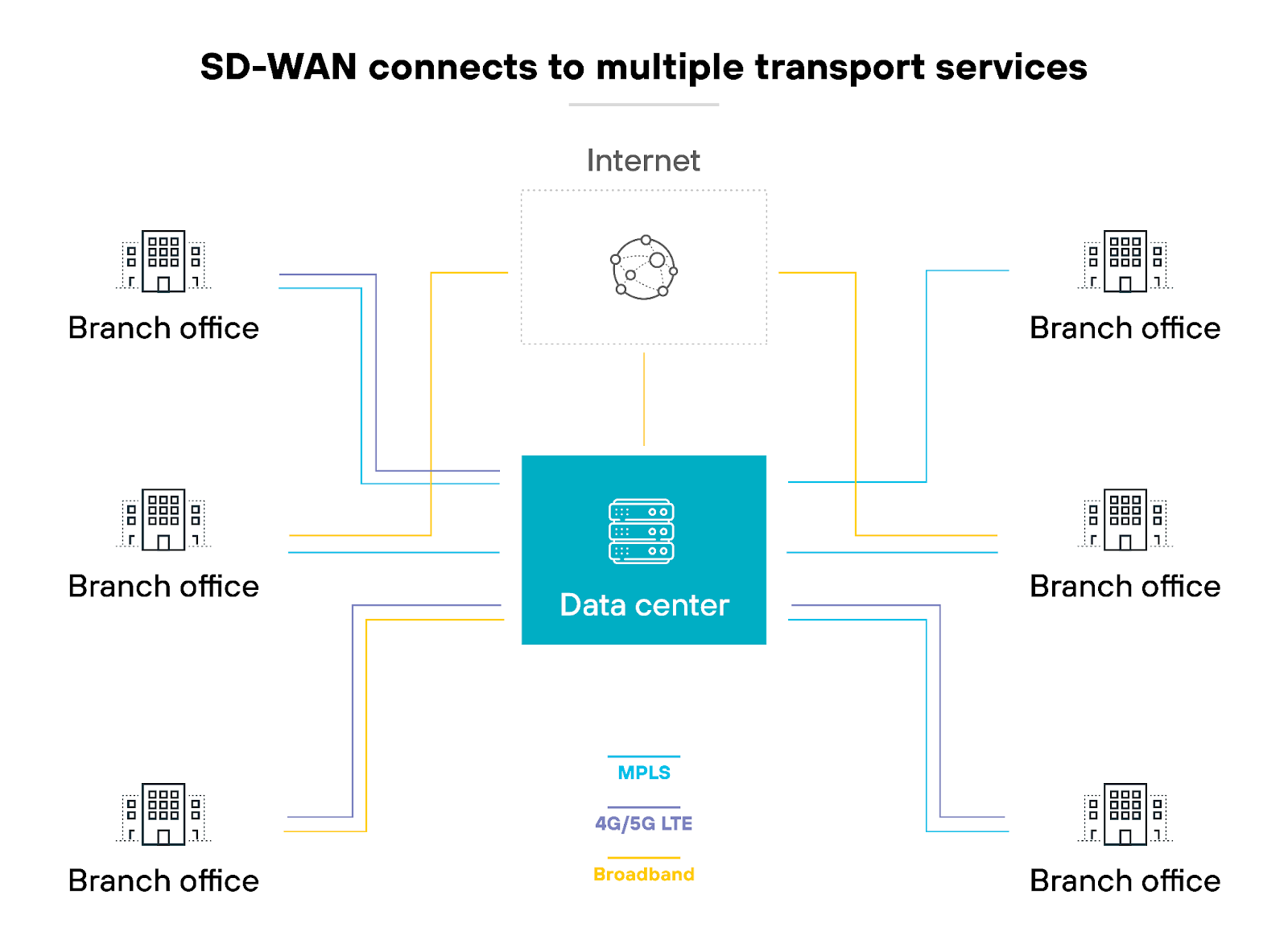
Each connection is treated as part of a larger, cohesive network. The appliance constantly monitors the performance of each link, gathering data on latency, packet loss, jitter, and overall reliability.
Step 2: Dynamic path selection
Using the performance data, the SD-WAN appliance dynamically selects the optimal path for each data packet.
This process, known as dynamic path selection, ensures that high-priority traffic (like real-time voice or video) takes the fastest, most reliable route. Lower-priority traffic (like email synchronization) is assigned to less expensive or lower-performing links.
Predefined policies govern the decision-making process. Network admins set the policies to specify criteria for routing decisions based on the type of traffic and current network conditions.
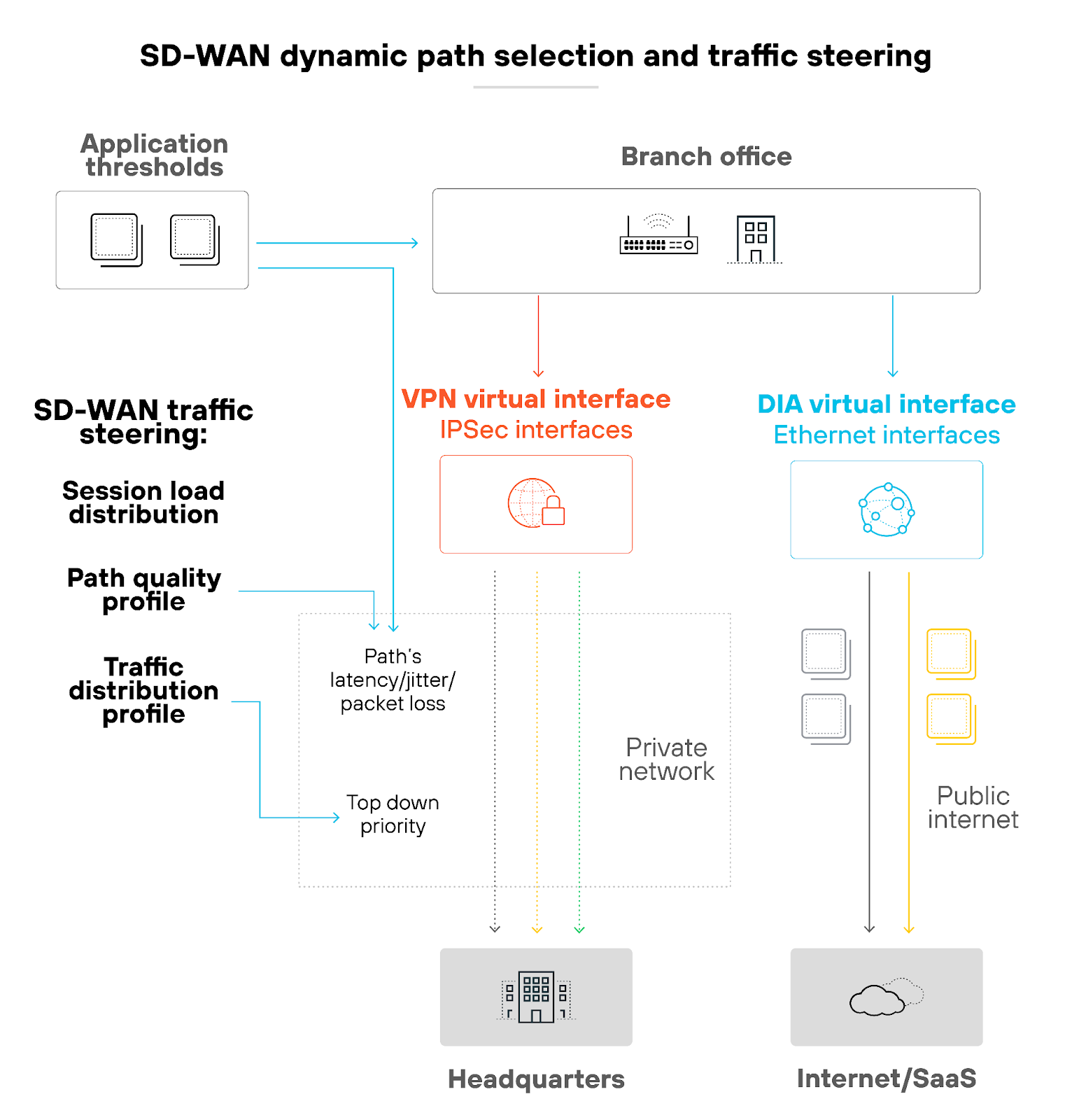
Step 3: Traffic steering
Once the optimal path is selected, the appliance directs the traffic along its chosen path while continuing to make real-time assessments.
This is called traffic steering.
Traffic steering takes into account the decisions made during dynamic path selection and moves the traffic dynamically depending on the network conditions it encounters. Which means traffic can be rerouted as necessary for the best possible performance and reliability.
For example: If an MPLS link experiences high latency, the appliance can reroute traffic through a broadband or LTE connection.
Traffic steering optimizes performance and makes the network more reliable by providing automatic failover in case of link failures.
Note: Dynamic path selection and traffic steering are related but distinct concepts. Dynamic path selection chooses the best path based on real-time network metrics. Traffic steering then directs traffic over the chosen path to maintain optimal performance.
Step 4: Encryption and security
As traffic travels through the network, the SD-WAN appliance applies data plane or control plane encryption to protect the privacy and integrity of data. Data plane encryption is typically used to secure the actual data being transmitted, ensuring its confidentiality across public and private networks.
Like this:
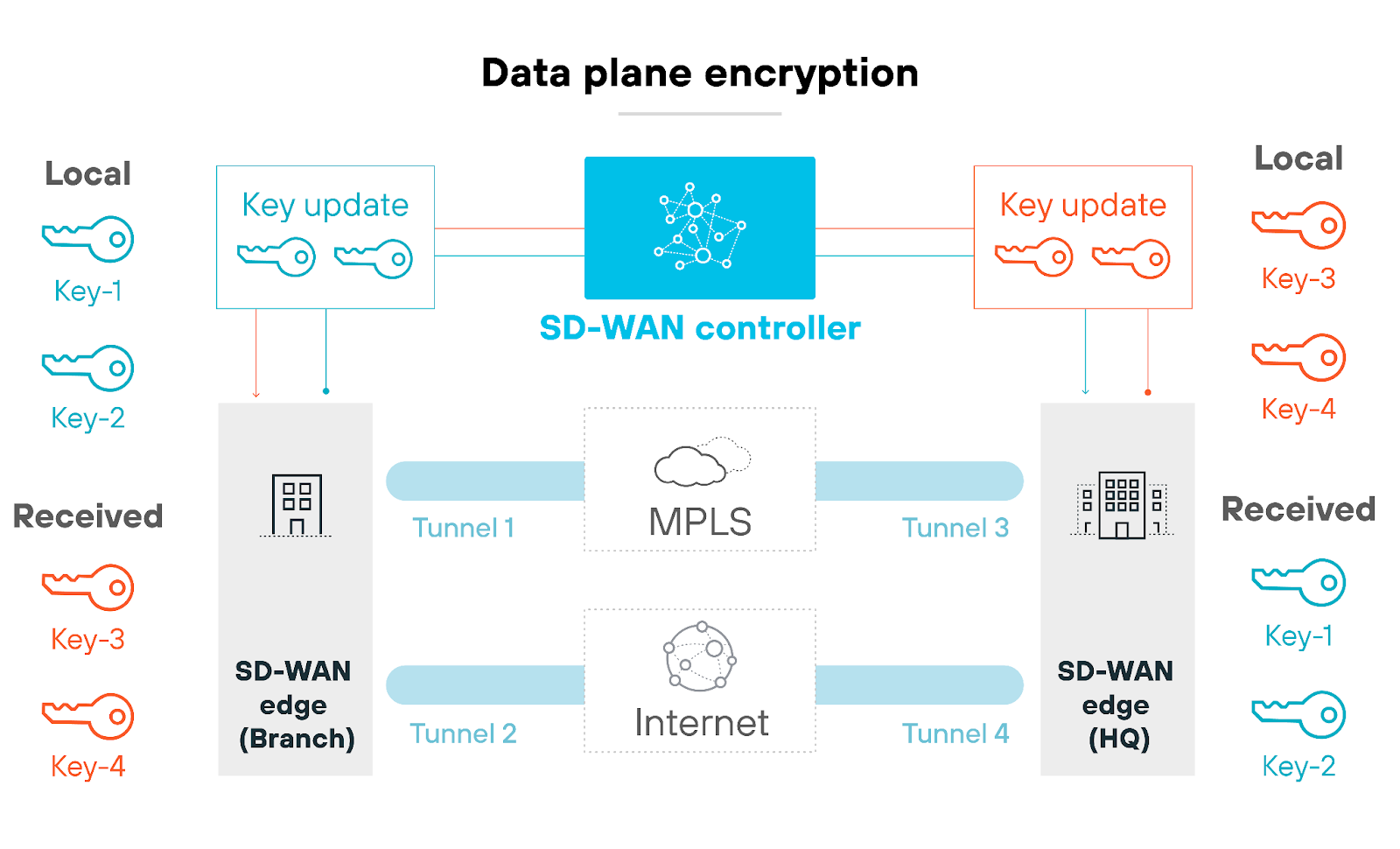
On the other hand, control plane encryption secures the signaling and management information exchanged between devices, maintaining the integrity of network operations.
Both are crucial for safeguarding sensitive information as it travels across public and private networks.
Depending on the solution, the appliance may also incorporate additional security measures to protect against threats, like firewall functionalities and intrusion detection systems.
Step 5: Connecting users to applications
SD-WAN appliances continuously connect users to applications and services efficiently throughout the entire process.
When a user initiates a connection, the appliance evaluates the best path based on the current network status and the requirements of the application.
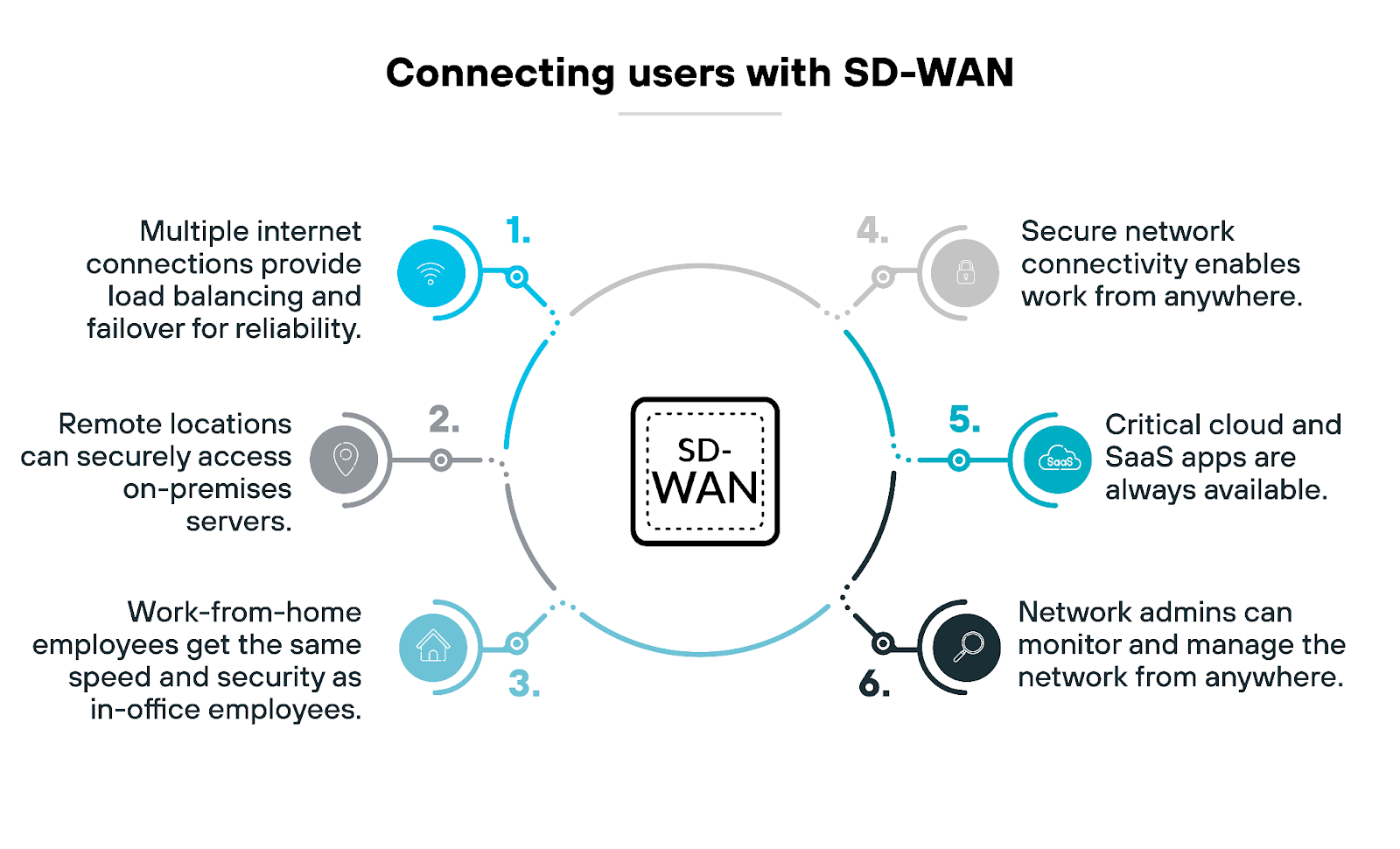
For example: A video conferencing application might be routed over a low-latency MPLS link, while general web browsing could be directed through a broadband connection.
Intelligent routing allows users to enjoy the best possible performance regardless of where they are.
Step 6: Centralized management and orchestration
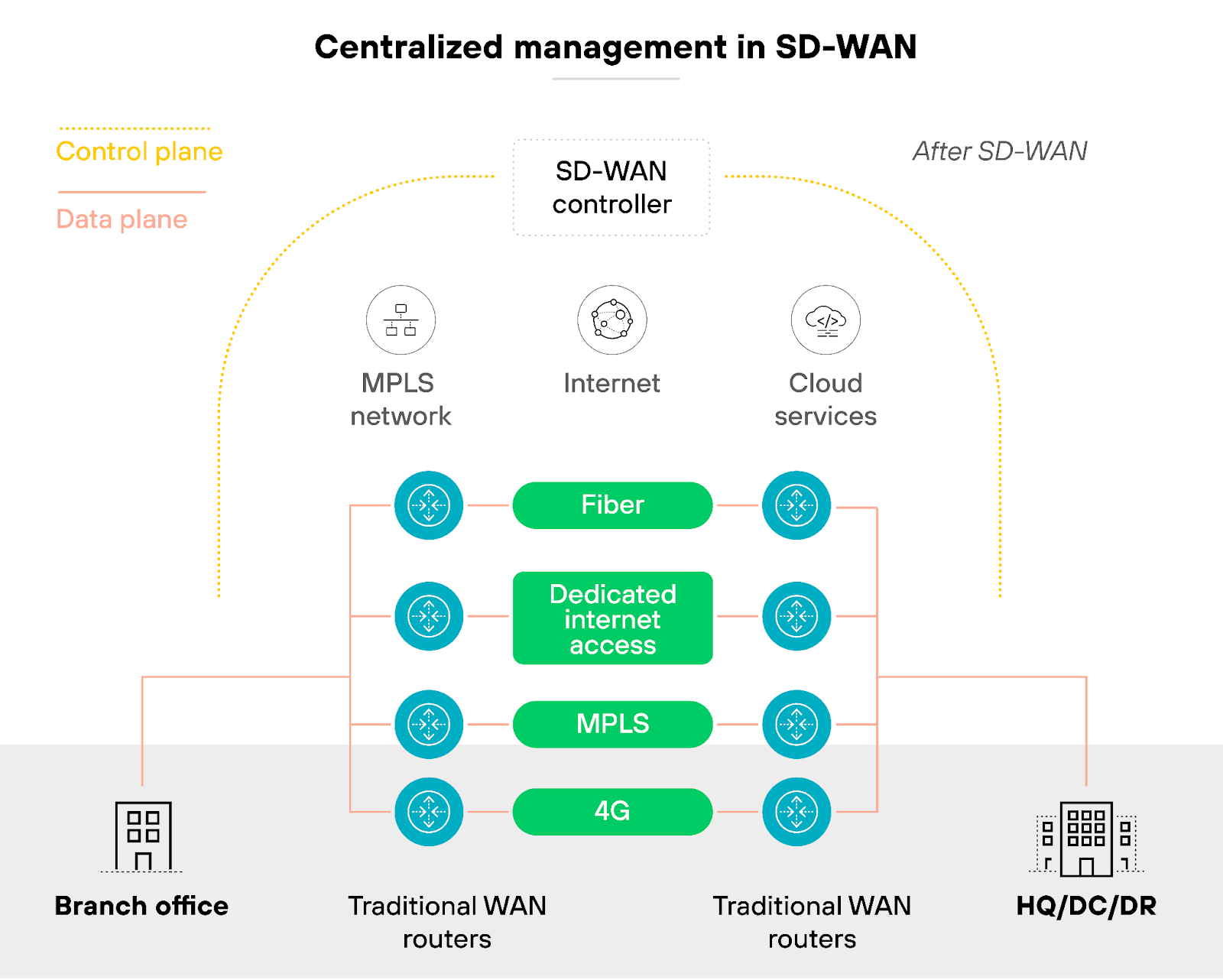
Centralized management and orchestration are an ongoing, core part of an SD-WAN appliance’s functioning more so than the final step. Basically, centralized management and orchestration are always running in the background.
As explained, network admins use a central controller to define policies and monitor network performance.
The SD-WAN appliances at each site automatically receive updates and instructions from this central controller. And this leads to consistent policy enforcement and network behavior across all locations.
Central management makes it a lot easier for admins to configure and maintain the network and adjust quickly when demands change.
What are the different types of SD-WAN appliances?
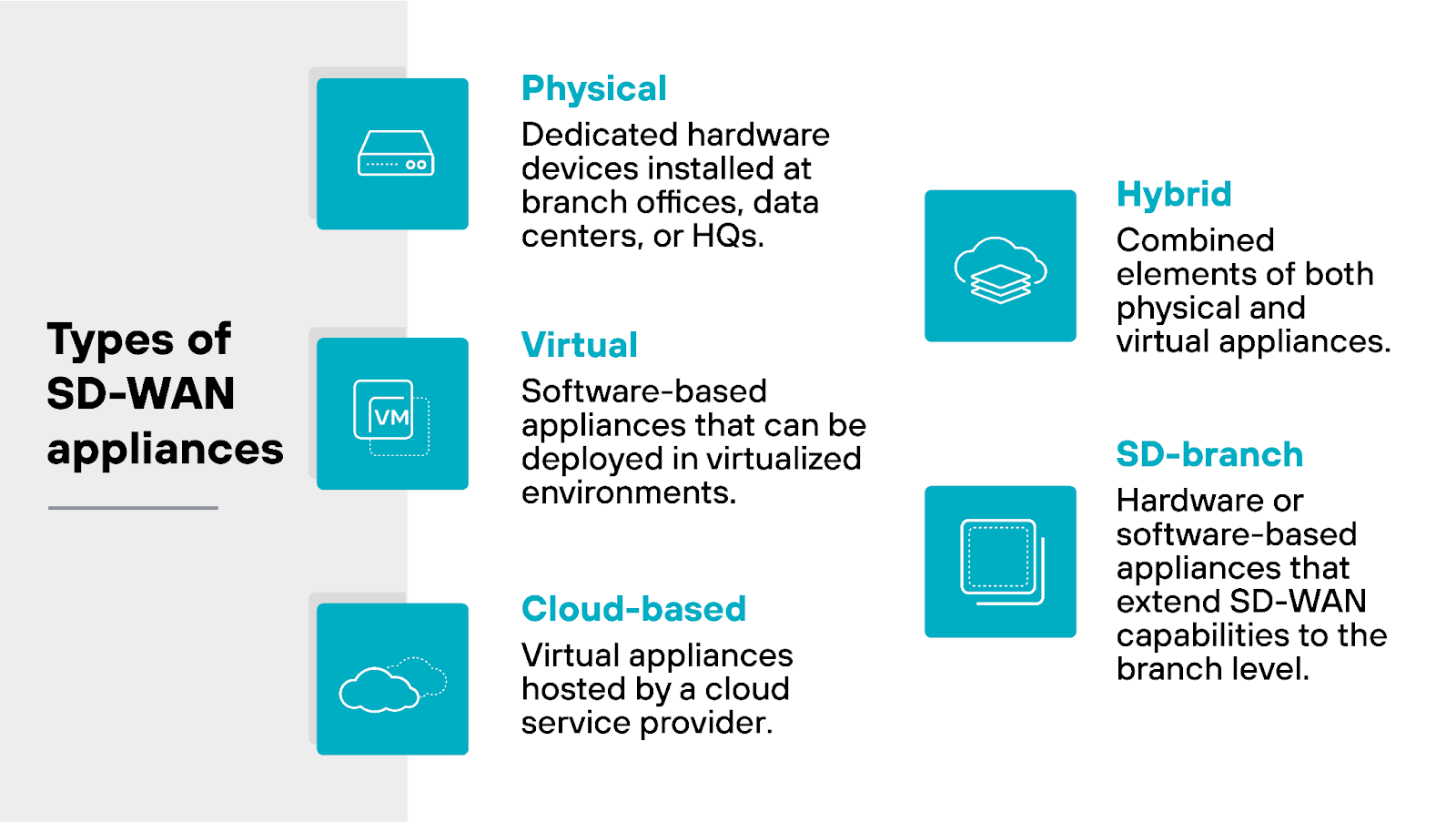
SD-WAN appliances come in various forms to cater to different networking needs and deployment scenarios.
Choosing the right type of SD-WAN appliance depends on an organization’s specific requirements, including performance needs, deployment scale, and management preferences.
Let’s break down the main categories of SD-WAN appliances and their distinct characteristics:
Physical SD-WAN hardware
These are dedicated hardware devices installed at branch offices, data centers, or headquarters.
Physical appliances are known for high performance and reliability. They tend to offer better throughput and processing power compared to their virtual counterparts.
Physical appliances often come equipped with specialized SD-WAN hardware components, like security processors (SPUs), which enhance their ability to handle complex security tasks. Such as encryption and intrusion prevention.
Organizations with large, high-traffic environments often prefer physical appliances for the superior high performance and reliability.
Virtual SD-WAN appliances
Unlike physical appliances, virtual appliances are software-based and can be deployed in virtualized environments, such as on virtual machines (VMs) in data centers or cloud platforms.
Virtual appliances are flexible and scalable, so they’re great for dynamic and rapidly changing environments. They can be easily scaled up or down based on demand. Plus, they can also coexist with other virtual network functions (VNFs) in a virtualized infrastructure.
This type of appliance is especially useful for organizations with a cloud-first strategy or the need to deploy SD-WAN across geographically dispersed locations without the overhead of physical SD-WAN hardware.
Cloud-based SD-WAN appliances
These are essentially virtual appliances hosted by a cloud service provider.
Cloud-based appliances rely on the scalability and global reach of public cloud platforms to provide SD-WAN services without the need for physical infrastructure.
This approach makes deployment and management easier because the public cloud provider handles the underlying infrastructure.
Cloud-based SD-WAN appliances are a good option for organizations with significant cloud workloads or the need to operate across multiple regions with consistent performance and connectivity.
Hybrid SD-WAN appliances
Hybrid SD-WAN appliances combine elements of both physical and virtual appliances. They offer the flexibility of virtual appliances with the performance benefits of physical devices.
In a hybrid deployment, an organization might use physical appliances at larger, high-traffic sites and virtual appliances at smaller or more remote locations. This setup allows for optimized performance where it’s needed most, but it’s still flexible and scalable.
Hybrid appliances are suitable for organizations with diverse networking needs and a mix of on-premises and cloud-based resources.
Software-defined branch (SD-branch) appliances
These are designed to extend SD-WAN capabilities to the branch level, integrating various network functions into a single appliance.
An SD-branch appliance typically includes SD-WAN, routing, firewall, and other network services. The consolidation reduces the need for multiple devices at branch locations. Which means management is easier and costs are lower.
SD-branch appliances tend to work well for organizations who want to streamline their branch network infrastructure while still using the advanced features of SD-WAN.
What are the different SD-WAN appliance deployment models?
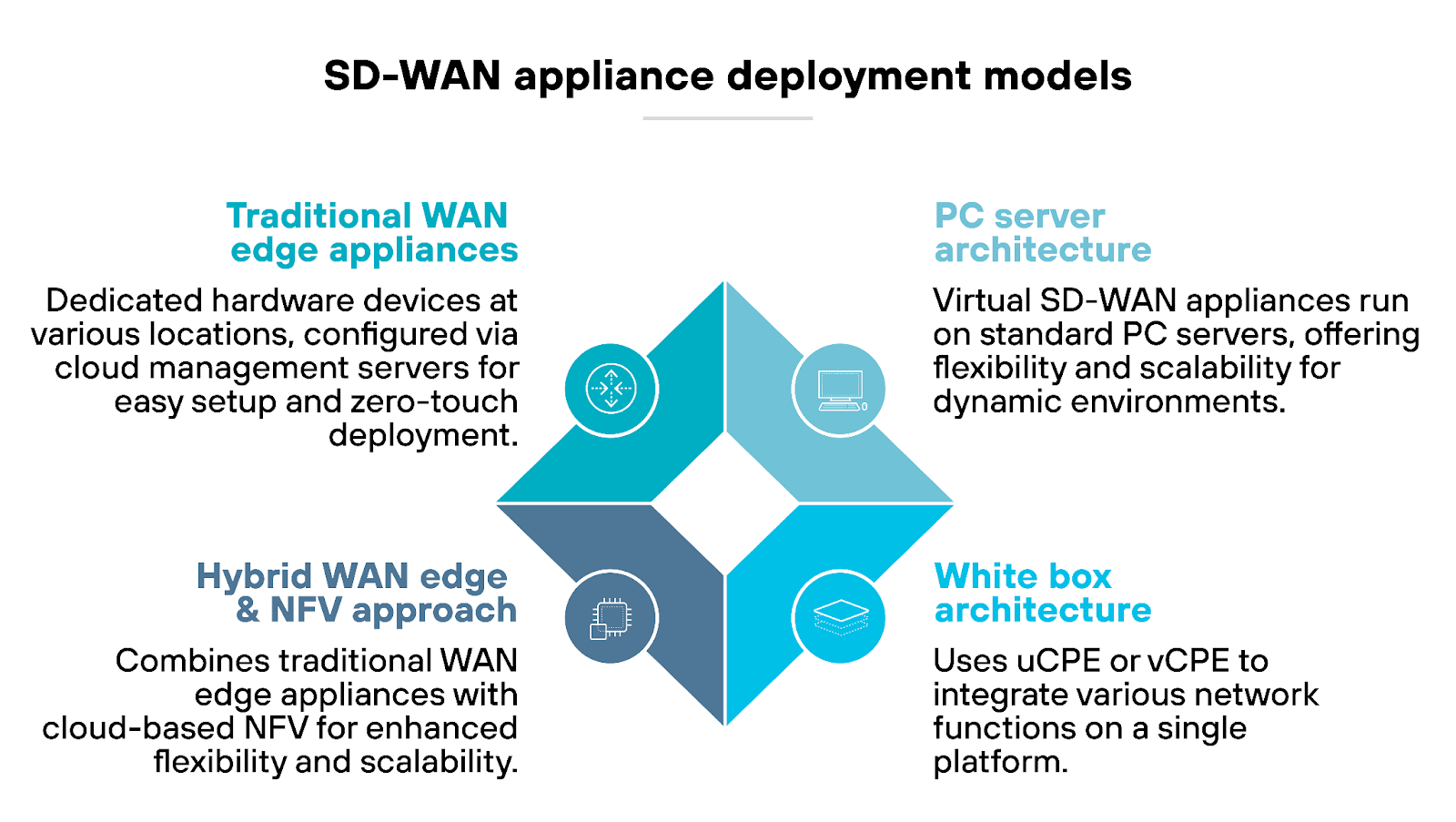
There are several variations on SD-WAN appliance configurations and infrastructure setups. This includes how SD-WAN appliances interact with different network environments.
The deployment model plays a role in determining the flexibility, scalability, and performance of the network. Which is why it’s important to choose the best configuration for specific needs and operational requirements.
Traditional WAN edge hardware
Traditional WAN edge appliances are dedicated hardware devices installed at branch offices, headquarters, or data centers.
They connect to multiple transport services. Cloud management servers usually handle their configuration, which makes setup and management easier.
Traditional WAN edge hardware often offers zero-touch deployment, making the installation process quick and simple.
PC server architecture
In this model, virtual SD-WAN appliances run on standard PC servers.
This setup is flexible and scalable. Management and adjustments based on network demands are fairly easy. Which makes it ideal for environments that need to adapt quickly and expand rapidly.
White box architecture
White box architecture uses universal customer premises equipment (uCPE) or virtual CPE (vCPE). This model allows organizations to select and implement vendor-specific features as needed.
It’s also cost-effective and flexible. Plus, it makes it possible to integrate various network functions on a single hardware platform.
Hybrid WAN edge and NFV approach
A growing trend in SD-WAN appliance deployment is the hybrid approach, which combines traditional WAN edge appliances with network functions virtualization (NFV).
This method uses cloud-based security and WAN optimization features as standalone NFV solutions. The combined approach provides a mix of on-premises and cloud-based functionalities.
It offers enhanced flexibility and scalability while optimizing network performance.
What are the benefits of SD-WAN appliances?
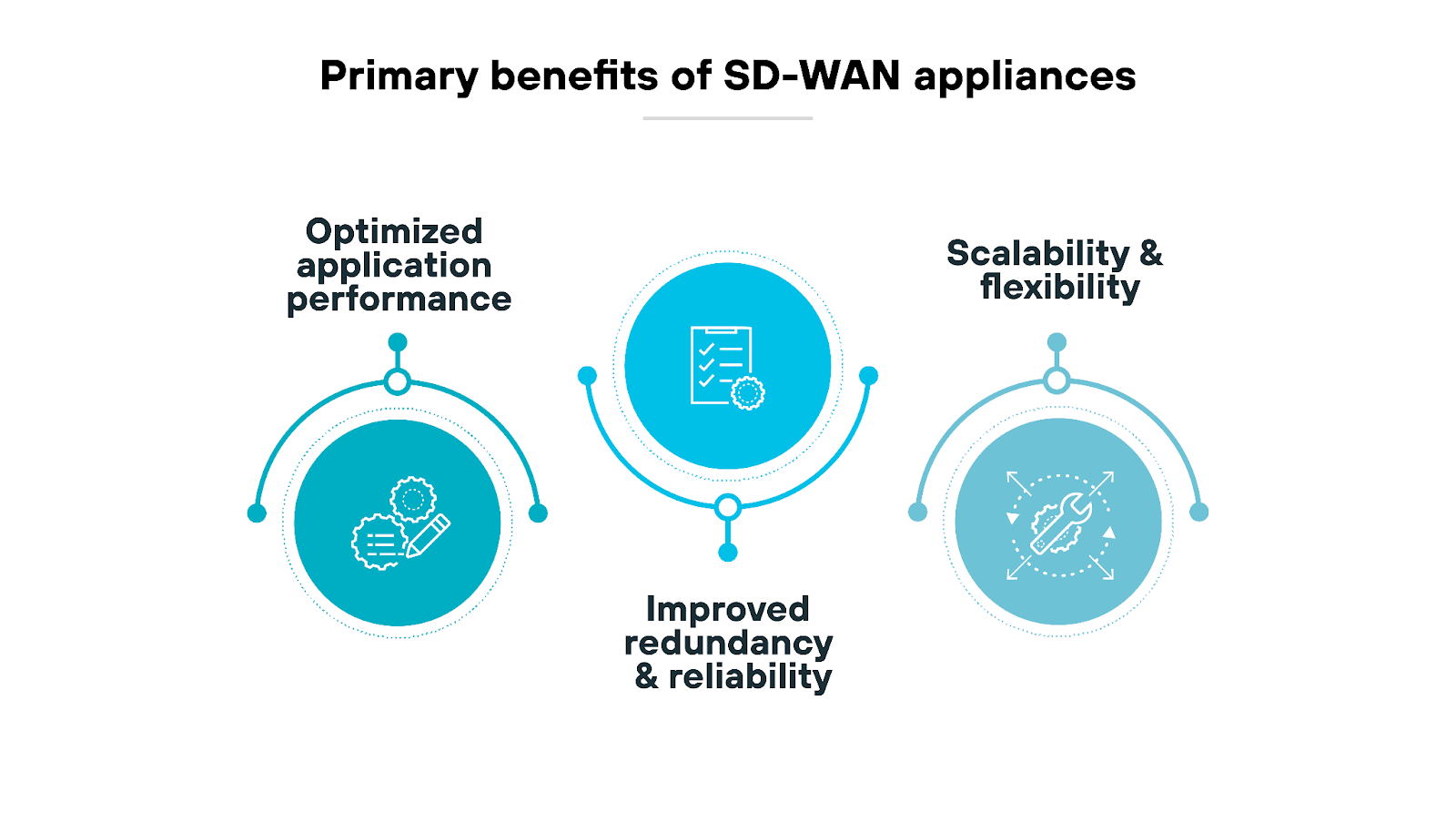
It’s worth noting that there are extensive benefits of SD-WAN as a networking technology. However, the appliances themselves are dedicated to executing the operations that make these benefits possible.
With this distinction made, the benefits of SD-WAN appliances can be summed up concisely: optimized application performance, improved redundancy and reliability, and scalability and flexibility.
Optimized application performance
SD-WAN appliances monitor network conditions continuously and dynamically route traffic. When critical applications receive the bandwidth and low-latency paths they need, performance is smooth and uninterrupted.
Improved redundancy and reliability
SD-WAN appliances, as established, can use multiple transport links. Their multi-path capability ensures that if one link fails or degrades, the appliance can reroute traffic automatically to another available link.
The result is a more resilient network that minimizes downtime and maintains connectivity. Even during link failures or performance issues.
Scalability and flexibility
SD-WAN appliances can scaled easily to accommodate new sites or increased traffic demands.
Virtual appliances, in particular, offer a high degree of flexibility. They can be deployed quickly in cloud environments or on virtual machines.
The overall adaptability makes it easier for organizations to expand networks as needs grow without significant investment in new hardware.
What are the common features of SD-WAN appliances?
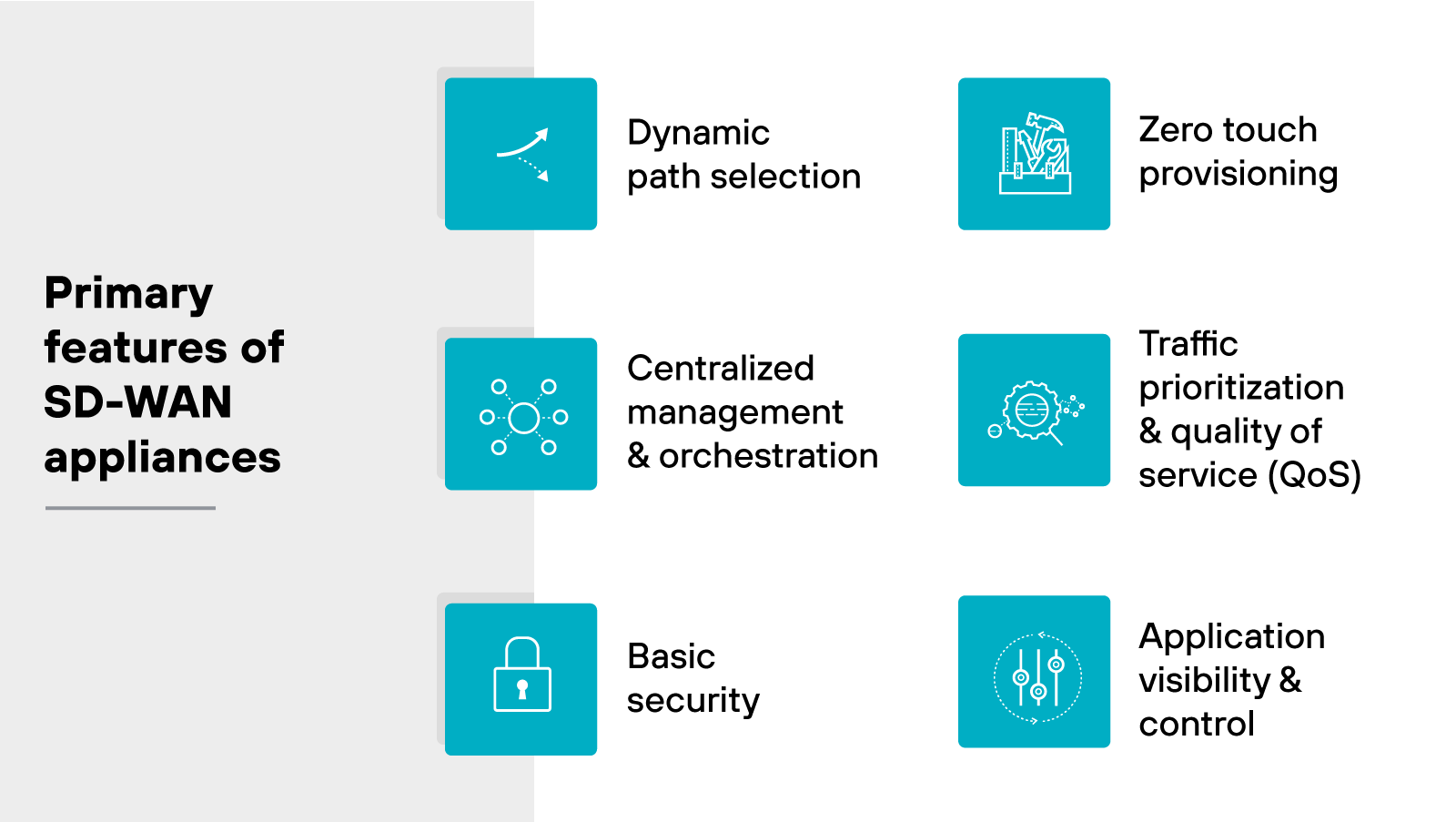
There’s a broad array of features you’ll find in the SD-WAN appliance market. Different organizations have varying networking needs and priorities, which has led to a range of functionalities engineered to address these requirements.
Despite the variety, there are a few common SD-WAN appliance features based on the core purpose of SD-WAN. These features address the more fundamental challenges that most organizations face.
Dynamic path selection
As explained, SD-WAN appliances continuously monitor the performance of multiple network connections: MPLS, broadband, LTE etc. Again, by analyzing metrics like latency, jitter, and packet loss, the appliances can dynamically route traffic over the most efficient path.
Centralized management and orchestration
Unlike traditional WANs that require manual configuration at each site, SD-WAN appliances offer centralized control through a management console.
Network admins can configure and manage the entire network from one interface. And that makes managing policies much simpler. Plus, it majorly lowers the risk of configuration errors.
Basic security
SD-WAN appliances generally provide basic protection mechanisms.
Many include built-in firewalls that monitor and control traffic based on security policies. Encryption capabilities are common, too.
Intrusion detection and prevention systems (IDS/IPS) are also often embedded in the appliances.
Zero touch provisioning
Zero touch provisioning simplifies the deployment process of SD-WAN appliances.
When new appliances are installed, they can automatically download the configuration and policies from a central controller.
This feature makes it much easier and quicker to set up new sites. Network admins can deploy the network fast, and scale efficiently.
Traffic prioritization and quality of service (QoS)
These features basically ensure that critical applications get resources they need to perform at the highest possible level.
SD-WAN appliances can prioritize traffic based on application type. Which ensures that important business applications have precedence over less critical traffic.
Quality of service (QoS) settings allow the appliance to allocate bandwidth appropriately. And that minimizes congestion and improves the user experience.
Note: Dynamic path selection and QoS are related but distinct concepts. Dynamic path selection chooses the best route based on real-time metrics, while QoS ensures critical applications receive the necessary resources for optimal performance by prioritizing traffic.
Application visibility and control
SD-WAN appliances provide detailed insights into network traffic. So network admins can see which applications are consuming bandwidth and how they’re performing. Which adds up to better decision-making and more effective network resource management.
Security considerations for SD-WAN appliances
As discussed, SD-WAN appliances typically come with a few basic security measures.
However, it’s important to note:
No single SD-WAN solution can address all potential threats. SD-WAN appliances provide a basic foundation by covering essential security needs.
Note: SD-WAN is a great solution if network performance and management are your primary concerns. However, it’s not designed for comprehensive security.
To achieve comprehensive network security, a multilayered approach is necessary. This approach may involve third-party solutions or a shift to secure access service edge (SASE). In either case, to address security, organizations need protection beyond the basic capabilities of SD-WAN appliances.
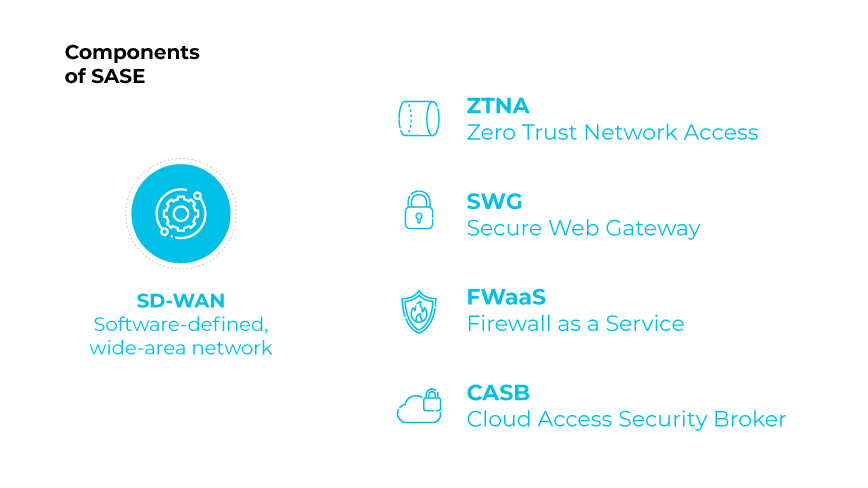
SASE combines SD-WAN capabilities with a suite of cloud-delivered security services, including:
- Secure web gateways (SWG)
- Cloud access security brokers (CASB)
- Firewall as a service (FWaaS)
- Zero trust network access (ZTNA)
This integrated approach offers a unified, scalable, and flexible security solution.
With this established, here are the common security features you’ll often find baked into many SD-WAN appliances:
Encryption
Encryption ensures data remains confidential as it moves across different network links. Regardless of how data travels, encryption protects it from interception by unauthorized parties. This is crucial for maintaining the privacy and integrity of sensitive information.
Firewall integration
Many SD-WAN appliances come with built-in firewalls that monitor and control incoming and outgoing network traffic based on predetermined security rules.
Firewalls help prevent unauthorized access to the network and protect against various cyber threats, like malware and denial-of-service attacks.
The firewalls in SD-WAN appliances are often designed to work seamlessly with network routing capabilities. This way, security measures coordinate with how data is directed through the network.
Intrusion detection and prevention systems (IDS/IPS)
IDS/IPS systems monitor network traffic for suspicious activity and can block potentially harmful traffic in real-time. Which is essential for identifying and mitigating threats before they can cause significant damage.
By analyzing patterns in network traffic, IDS/IPS systems can detect anomalies that might indicate a cyber attack.
Further reading:
How to choose the right SD-WAN appliance for your needs
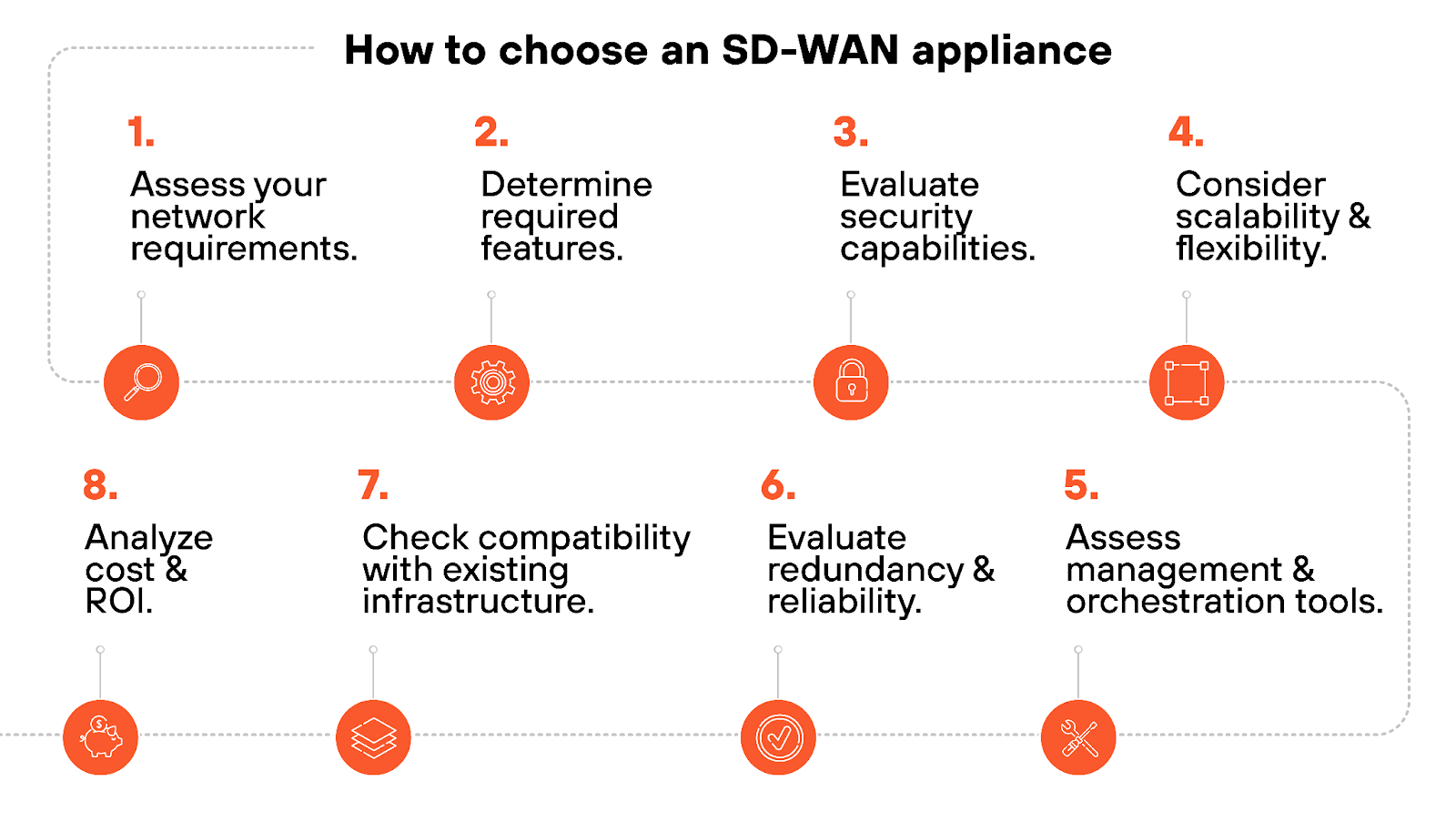
If you’re shopping around for SD-WAN appliances, you probably know that there’s a lot of variation in features and capabilities from one appliance to another.
For example: Maybe the appliance you have your eye on offers most of the features and functionalities you want, but only facilitates packet based routing when you need flow based.
Not all SD-WAN provider appliances are created equally, which doesn’t especially help the procurement process.
Here’s a step-by-step guide to help you navigate the SD-WAN appliance evaluation process:
1. Assess your network requirements
Start by evaluating your current network infrastructure and requirements.
- Understand the volume of traffic your network handles and the types of applications that are most critical.
- Identify the locations that need to be connected and the types of connections available at each site.
This initial assessment will help you determine the necessary specifications for your SD-WAN appliances, such as bandwidth capacity and the number of supported connections.
2. Determine required features
Next, identify the key features your SD-WAN appliance must have to meet your specific needs.
Consider features like dynamic path selection, centralized management, and security capabilities.
For example: If ease of deployment is a priority, ensure the appliance supports zero-touch provisioning.
3. Evaluate security capabilities
Security isn’t SD-WAN’s focus area, but that doesn’t mean you shouldn’t consider it.
Note: If your goal is complete security on top of network performance and management, you’ll need to combine appliance features with third-party solutions or consider a shift to SASE.
- Determine your security needs and expectations.
- Assess the security features offered by different appliances and look for options that reflect your needs.
- Don’t forget: Consider how the appliance handles security for remote users and cloud access.
Tip: If you plan to integrate an existing security solution with your SD-WAN appliance, mention this early in the procurement process. Not all SD-WAN appliances support security integrations.
4. Consider scalability and flexibility
Know your growth plans.
- If scalability and flexibility are primary concerns, focus on options that can scale with your organization’s growth. (This is less important when it comes to static networks or short-term deployments.)
- Ensure the appliance can support the addition of new sites and increased traffic without significant hardware investments.
Tip: Virtual appliances are flexible and easy to deploy in cloud environments. Keep this in mind if your network is especially dynamic and prone to rapid changes.
5. Assess management and orchestration tools
Effective management and orchestration are vital for the smooth operation of your SD-WAN.
While many SD-WAN appliances offer management and orchestration tools, the specific capabilities and ease of use can vary between different appliances and vendors.
Here’s what to consider:
- Feature set: Identify the management features you need, like real-time network visibility, application performance monitoring, automated policy updates, etc.
- User interface: Evaluate the ease of use and intuitiveness of the management interface. A more user-friendly interface reduces the learning curve and administrative burden.
- Integration: Check how well the appliance integrates with your existing network management tools or third-party services for a cohesive management experience.
- Vendor-specific enhancements: Consider any unique management features or enhancements offered by different vendors that may provide additional value or capabilities.
6. Evaluate redundancy and reliability
Redundancy and reliability are important for making sure that network operations remain uninterrupted. At the same time, specific implementations can vary significantly based on organizational needs.
Different businesses have unique requirements for maintaining uptime, whether it's ensuring continuous customer access, supporting remote workforces, or managing critical applications.
Here’s how to assess redundancy and reliability in SD-WAN appliances to match your needs:
- Multiple network paths: Verify that the SD-WAN appliance can leverage multiple network paths to ensure continuous connectivity.
- Automatic failover capabilities: Ensure the appliance provides automatic failover to reroute traffic seamlessly if one link fails.
- Traffic rerouting: Evaluate how efficiently the appliance handles traffic rerouting to maintain smooth operation during network disruptions.
- Performance during disruptions: Assess the appliance's performance in maintaining connectivity and minimizing downtime when network issues arise.
- Vendor-specific features: Consider any additional redundancy and reliability features offered by different vendors that could benefit your specific network needs.
7. Check compatibility with existing infrastructure
Every organization has unique existing systems and varying transport types.
Ensuring compatibility with your existing network infrastructure minimizes disruptions and simplifies the deployment process.
Here’s how to evaluate compatibility effectively:
- Current network equipment: Confirm that the SD-WAN appliance can integrate with existing routers, firewalls, and other networking equipment.
- Interoperability: Assess the appliance’s ability to work with various network protocols and standards to avoid compatibility issues.
- Vendor support: Look into the vendor’s support for seamless integration and their experience with similar deployments.
- Transition simplicity: Evaluate how easily the appliance can be deployed in your existing network environment without causing significant disruptions.
8. Analyze cost and ROI
Finally, consider the cost of the SD-WAN appliance and its potential return on investment (ROI).
- While initial costs are important, also evaluate the long-term savings from reduced management complexity, improved network performance, and lower bandwidth costs.
- Look for appliances that offer a good balance between cost and functionality, providing the features you need without unnecessary expenses.
SD-WAN appliance FAQs
An SD-WAN appliance is a hardware or virtual device that enables the deployment and management of SD-WAN networks, monitoring multiple connections to dynamically route traffic efficiently and securely.
An SD-WAN device is not just a router; it provides additional functions like dynamic path selection, traffic steering, and built-in security features such as firewalls and encryption.
Yes, an SD-WAN appliance can replace traditional routers by offering advanced networking features, including dynamic path selection and integrated security, which traditional routers typically lack.
SD-WAN can use hardware appliances or virtual appliances, depending on the deployment needs. Both types are capable of managing SD-WAN networks effectively.
Necessary SD-WAN equipment includes either physical hardware appliances for robust performance or virtual appliances for flexibility, depending on the specific networking and deployment requirements.
